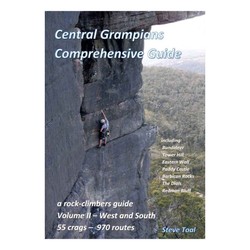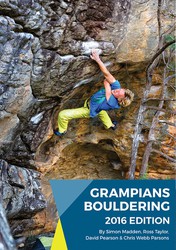Saison
Description
Big! Not ideal in winter as it faces south (though there is the nice little buttress on the north side).
One of the earliest climbing spots in Gariwerd. The original climbs are big, historic routes but it is also true that they are serious climbs with poor protection and fragile rock. As they are very rarely climbed they will also be dirty. Don't underestimate these easy climbs, they were put up by very good climbers with very little protection.
The modern climbs are much more attractive and some of them even have decent protection! But not all...
While the cliff is large, numerous escape opportunities reduce the seriousness of many of the climbs. For climbs left of "John The Baptist" is possible to get off the cliff quite easily after most pitches.
In the old days climbers referred to this area as The Temple, hence the naming theme of many of the early climbs. This name as been discarded as, outside those older climbing circles, the cliff is univerally known as "The Chimney Pots".
© (jgoding)Limit. de l'accès hérité de Grampians
Climbing restrictions apply to many crags in Gariwerd/Grampians. Some of these restrictions are likely to change over time as assessments are completed. Tags are being applied to most crags to reflect their current status. Additional access-notes are provided to clarify restrictions where required (and will over-ride this notice). Current and further Parks Victoria advice can be found at https://www.parks.vic.gov.au/places-to-see/parks/grampians-national-park/rock-climbing-in-gariwerd
Approche
Park on the Glenelg River Road where a sign points to the Chimney Pots. Follow the walking track, taking all of the left-hand forks to reach the foot of the south-west face. The track hits the bottom of the face midway beteen "Catwalk" and "John The Baptist".
GR 095620
© (jgoding)Éthique hérité de Grampians
Grampians / Gariwerd access issues have emerged (2019) due to potential risk to the environment and cultural sites. Climbers need to be aware that there are significant Aboriginal sites in the Grampians, especially in cave areas. Please take time to understand the access situation. Leave no trace and climb responsibly.
Please note that due to the fact that the Grampians is a National Park, dogs and other pets are not allowed in the park except in vehicles on sealed roads and in sealed car parks.
===Cliffcare Climber’s Code===
Find out about and observe access restrictions and agreements.
Use existing access tracks to minimise erosion - keep to hard ground & rock surfaces.
Do not disturb nesting birds or other wildlife.
Protect all native vegetation, especially at the base of cliffs. Wire brushing to remove mosses and 'gardening' in cracks and gullies is not permitted. Use slings to protect trees while belaying or abseiling if belay anchors are not provided.
Respect sites of geological, cultural, or other scientific interest. Do NOT develop new climbs in or near Cultural Heritage sites.
Chalk has high visual impact - minimise your use of it. Parks Victoria have requested the use of coloured chalk in Gariwerd.
Minimise the placement of fixed equipment, especially where Trad gear is available. Respect any "no bolting" areas.
Do not leave any rubbish - take it home with you.
Dispose of human waste in a sanitary manner (bury, or even better pack it out). Do not pollute water supplies.
Off-road driving is illegal in Gariwerd.
Keep campsites clean, and do not light campfires outside of official metal fire pits.
For more detailed information visit https://www.cliffcare.org.au/education
Tags
Planifiez votre voyage
Certains contenus ont été fournis sous licence de : © Australian Climbing Association Queensland (Creative Commons, Attribution, Share-Alike 2.5 AU)
Bonjour !
Ici pour la première fois ?
theCrag.com est un guide gratuit pour les sites d'escalade partout dans le monde, édité en collaboration par des grimpeurs passionnés, des bloqueurs et d'autres gens sympathiques.Vous pouvez enregistrer toutes vos ascensions, vous connecter et discuter avec d'autres grimpeurs et bien plus encore...» partez à la découverte, » en savoir plus or » posez-nous une questionSelected Guidebooks plus Cacher
Auteur·e·s: Steve Toal
Date: 2019
The Central Grampians Comprehensive Guide books are the most extensive climbing guide to the Grampians. With two volumes they cover the popular areas but also many of which have never been in print before.
Volume 1 of the Central Grampians guide covers the North and East regions and features over 1400 routes spread over 124 crags. Painstakingly put together by Steve Toal, his guides have now become the go-to for climbers for the area.
Auteur·e·s: Steve Toal
Date: 2019
The Central Grampians Comprehensive Guide books are the most extensive climbing guide to the Grampians. With two volumes they cover the popular areas but also many of which have never been in print before.
Volume 2 of the Central Grampians guide covers the West and South regions and features over 970 routes spread over 55 crags. Painstakingly put together by Steve Toal, his guides have now become the go-to for climbers for the area.
Auteur·e·s: Simon Madden, Ross Taylor, David Peason and Taylor Parsons
Date: 2016
ISBN: 9780646955544
"Australia's premier bouldering destination! The new 2016 Edition Grampians Boulder guide authored by Simon Madden, Ross Taylor, David Peason and Taylor Parsons. It contains more than 1300 problems which is double the original guide. Heaps of new information on established areas as well as the inclusion of plenty of boulders and crags not published before. It also features update idiot proof layout and expanded history and culture notes. Get one and start cranking!"
Logements à proximité plus Cacher
Partager ceci
Photos Rechercher parmi toutes les photos
/e0/36/e0366e874c8a4a661d8713ebe46215de1e5aa770)
Pope's Nose Area - Pope's Nose south face
/f5/6a/f56ac18b603b4089bc6ed618c053ff91a6a80291)
Pope's Nose Area - Pope's Nose
Get a detailed insight with a timeline showing
- Ticks by climbers like you
- Discussions of the community
- Updates to the index by our users
- and many more things.
Login to see the timeline!



